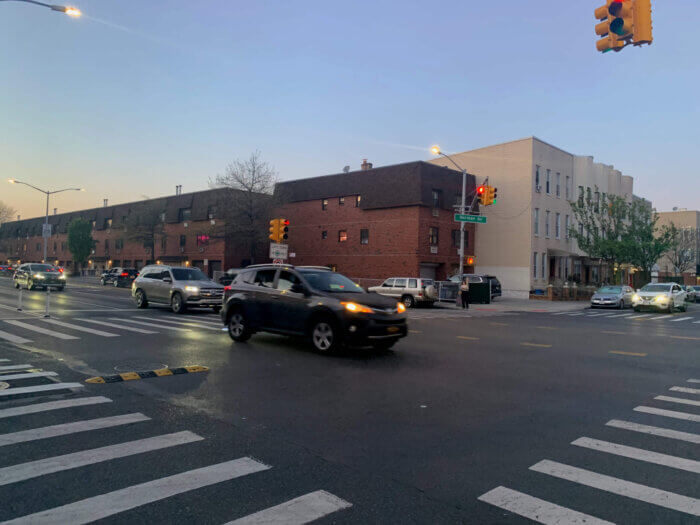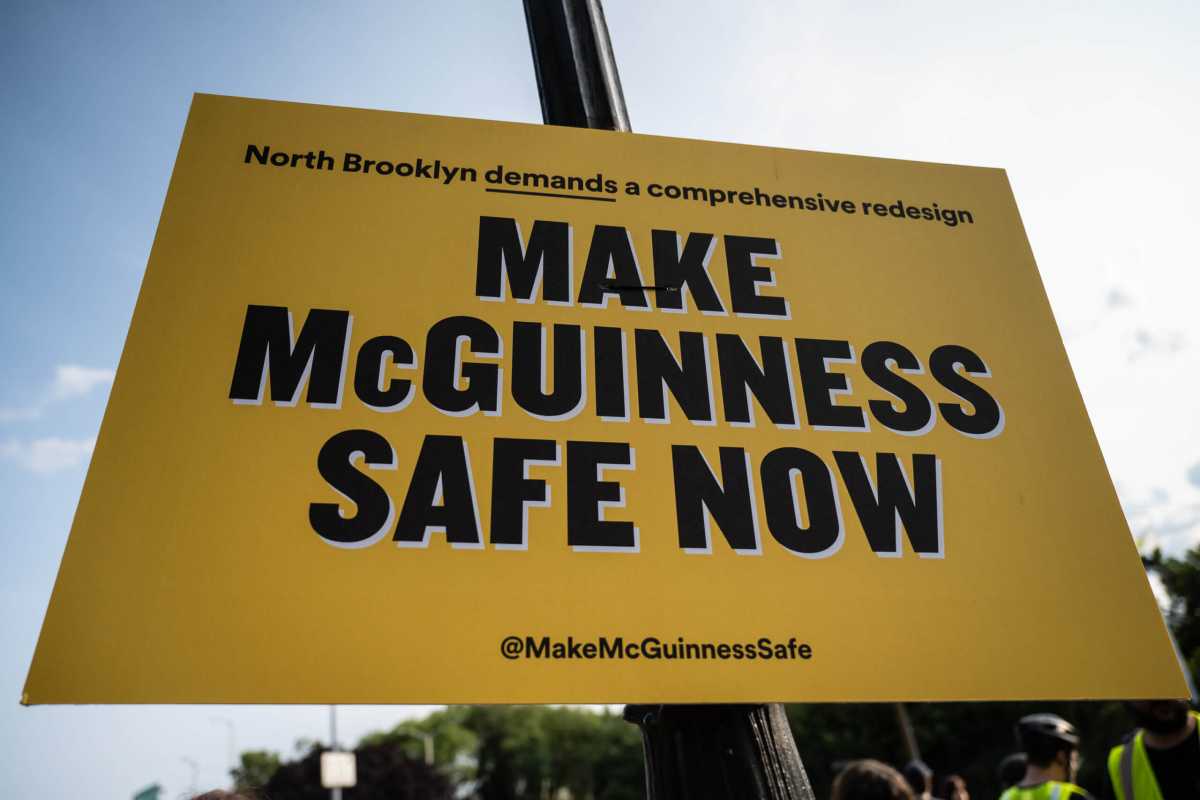The Department of Transportation unveiled a compromised version of its planned redesign of McGuinness Boulevard Wednesday to the relief of many Greenpoint locals who have been fighting for safety improvements to the deadly highway-like road for over two years.
Advocacy group “Make McGuinness Safe” said its members are grateful that a “vast majority” of the previously agreed-upon road diet is moving forward after recent controversy, and City Hall said it is committed to beginning work on the project before school starts in early September.
The redesign will create a continuous protected bike lane connecting to the Pulaski Bridge, according to the DOT. From Meeker Avenue to Calyer Street, McGuinness Boulevard will feature one vehicle travel lane in each direction in addition to a parking protected bike lane in each direction.

From Calyer Street to the Pulaski Bridge, the redesign will have two peak-hour vehicle travel lanes from 7 a.m. – 7 p.m., and protected bike lanes in each direction. During off-peak hours the right lane in each direction will serve as a parking lane. Protection will be a mix of barriers where feasible and flexible delineators to allow passengers to access the curb.
DOT’s initially-proposed redesign would seen the entirety of McGuinness Boulevard reduced to one vehicle lane 24/7.
Kevin LaCherra, a longtime Greenpointer and member of Make McGuinness Safe, told Brooklyn Paper that they are grateful that changes will be made but that they intend to keep fighting until the entire corridor is safe.
“These changes to the plan will make the road diet less effective and less safe and are only happening because of the massive astroturf campaign that has been waged against the people of Greenpoint by Broadway Stages,” Make McGuinness Safe said in a statement, adding that they will “continue to fight for a McGuinness that prioritizes the safety of the people over the profits of the ultra rich.”
For years, locals have called on the city to redesign notoriously dangerous four-lane roadway — and in May, after years of meetings, surveys, and workshops, DOT unveiled what was thought to be their final proposal.
Weeks later, opposition group “Keep McGuinness Moving” — a coalition of local businesses led by Broadway Stages — ramped up its criticism of the plan, calling the proposed redesign McGuinness Boulevard’s “worst makeover yet,” and claiming it would “destroy the local economy” by cutting down on the number of vehicle lanes on the boulevard.
In response, Mayor Eric Adams withdrew his support of the agreed redesign of McGuinness, and ordered the DOT to come up with an alternative to the road diet, which would have seen the removal of one vehicle lane in each direction in favor of a bike lane.

A City Hall spokesperson said the updated redesign announced this week will calm traffic, create protected bike lanes, and better accommodate everyone traveling through the neighborhood, noting that the administration has “continuously listened to members of this community and updated our design accordingly.”
“Traffic safety is a key priority for Mayor Adams, and we are delivering with a redesign of McGuinness Boulevard that will make this corridor safer for all road users. Too many New Yorkers have been injured or lost their lives on McGuinness Boulevard, and the city has made significant safety improvements in recent years – both under the Adams administration and with Mayor Adams’ support when he was borough president,” the spox added.
Reacting to the updated redesign, opposition group ‘Keep McGuinness Moving’ said the “rushed” plan “is not an answer and is merely a knee jerk reaction to the media and community hype and a clear frustration at the stagnation of a workable plan.”
“The community is deeply concerned about the impact of diverted traffic on our residential side streets, delayed emergency response times, and many other issues affecting residents and businesses – not only in Greenpoint, but in neighboring areas such as Williamsburg, Bushwick, Long Island City, Maspeth, etc,” Keep McGuinness Moving said in a statement, adding that the group “will not stop advocating until McGuinness Boulevard is safe AND functional for all.”.
According to DOT data, 230 people were injured in crashes on McGuinness Boulevard between 2016 and 2020. Most — 176 — were drivers or passengers in vehicles. Most recently, a moped rider was left with a broken leg after being hit by a driver who was fleeing the scene of a nearby collision on the roadway.
The death of Matthew Jensen, a P.S. 110 teacher who was killed in a hit-and-run in 2021 on the road which stretches 1.5 miles from the Brooklyn-Queens Expressway at Meeker Avenue to the Pulaski Bridge, galvanized the community movement for a safety redesign.
Northern Brooklyn pols welcomed the compromise a “critical step in the right direction” and said their office will push for “swift implementation” in the weeks and months ahead.
“This process wasn’t always straightforward but we appreciate that the Adams administration never walked away from the table. We look forward to continuing to work with the Administration, the Department of Transportation, and our community to make North Brooklyn’s streets safer for all,” Brooklyn Borough President Antonio Reynoso, Assembly Member Emily Gallagher, Senator Kristen Gonzalez, Council Member Lincoln Restler and Congresswoman Nydia Velázquez said in a joint statement.

























